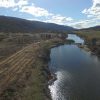Savannah, Georgia, one of America’s most popular tourist destinations, faces a critical threat from rising sea levels and frequent storms. Established in 1733 and recognized for its historical charm, Savannah is now at risk of losing some of its treasured neighborhoods to the encroaching sea. This issue has gained urgency as studies highlight the city’s vulnerability to severe flooding and coastal erosion.
Recent research underscores the severity of the situation. A study published in *Nature* identified 135 square miles around Savannah as already prone to severe flooding during high tides, a condition expected to worsen significantly by 2050. The area at risk could expand to 184 square miles, potentially inundating iconic areas such as River Street, known for its bustling waterfront and historic ambiance.
The city’s dilemma is compounded by two main factors: rising sea levels and subsidence, or coastal sinking. Coastal researchers warn that sea levels on the East Coast could rise by about a foot by 2050, which, combined with the land sinking by nearly an inch each decade, poses a dire threat to Savannah. This subsidence, along with increased flooding, significantly exacerbates the risk to the city’s low-lying areas.

The threat of flooding is projected to increase substantially in the coming decades. Studies indicate that Savannah will face at least one flood exceeding four feet by 2050 and potentially more than six feet by 2120. These floods are expected to have devastating impacts on the city, with neighborhoods between rivers, creeks, and marshes being particularly vulnerable.
Local residents and officials are already grappling with these challenges. In Savannah and nearby areas like Tybee Island, preparations are underway to mitigate the effects of rising sea levels and frequent flooding. Investments in infrastructure resilience, such as elevating homes and building up dunes, are being made to help communities adapt to the changing conditions.
Despite these efforts, experts warn that the scale of the problem might outpace the current measures. In Tybee Island, where sea level rise is particularly pronounced, residents have had to undertake expensive repairs and home elevation projects due to previous storm damages. The island’s elevation is so low that it is highly susceptible to tidal surges and storm impacts.
The situation is also reflected in other coastal communities. In Brunswick, for example, residents face regular flooding and are constantly preparing for heavy storms. The challenges facing these communities are a stark reminder of the urgent need for comprehensive strategies to address sea level rise and flooding.
Recent events, such as Hurricane Debby, have highlighted the growing severity of flooding issues. Savannah experienced unprecedented flooding, with extensive rainfall causing significant damage and requiring emergency responses. As hurricane seasons become more intense, the city and its residents must continue to adapt and prepare for increasingly frequent and severe flood events.

